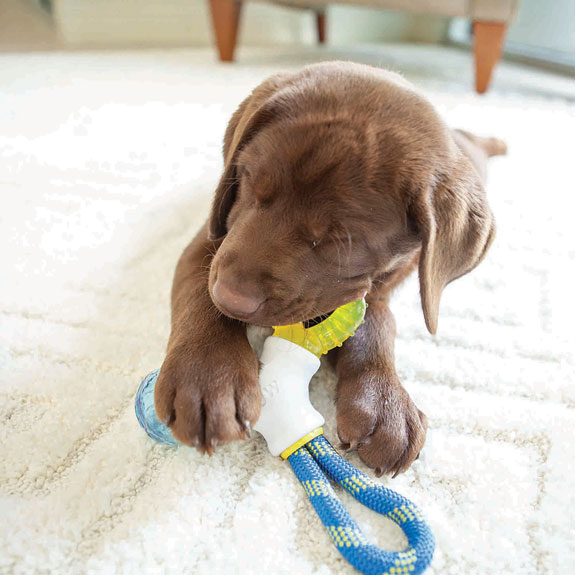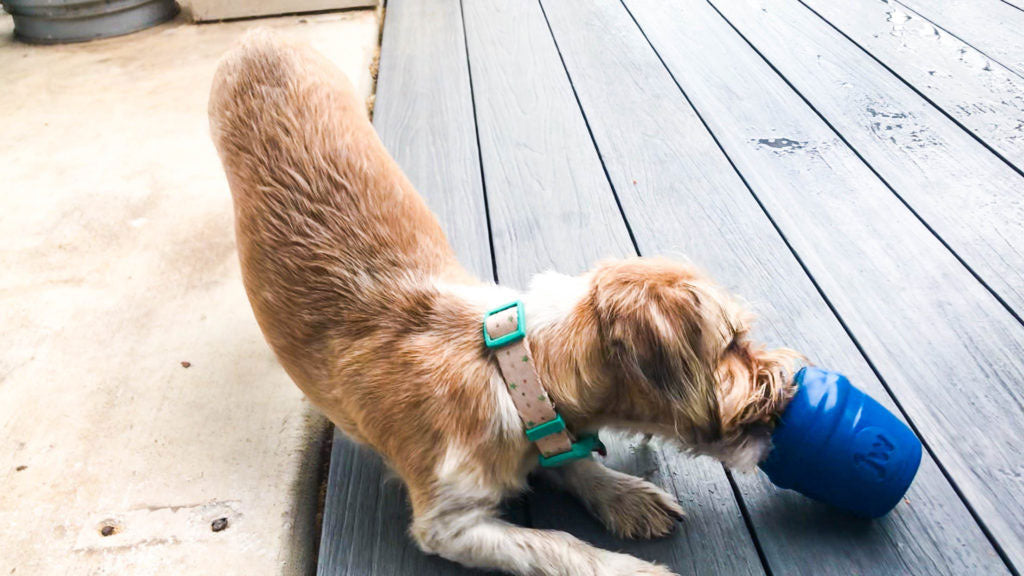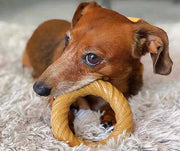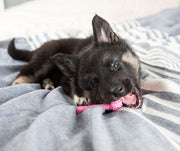Destructive Dog Chewing No More

It's normal and a natural instinct for puppies and dogs to chew on objects. From bones to rubber or nylon chew toys, even shoes, it seems as if nothing is safe. To us, chewing outside of eating may seem like nothing more than a destructive habit, but it does serve its purpose.
Chewing accomplishes a number of things for dogs of all ages. For puppies, chewing is an effective way to relieve pain while teething, and for older dogs, it's for oral hygiene. It also combats boredom and can relieve mild anxiety or frustration. While chewing is to be expected, there are certainly times when chewing can become excessive and destructive. Your dog may start chewing every object in sight, destroy your things, and exhibit other unruly behaviors.
Here, we've put together some tips for pet parents to help supervise their dogs, stop destructive chewing, save household items from danger, and coexist with a calmer, happier pup.
DETERMINE THE CAUSE
There are several possible causes for your dog's destructive chewing behavior, from separation anxiety to hunger, to stress or frustration. Whenever a dog is separated from its owner or left alone for long periods of time, the dog can develop destructive chewing habits, either out of boredom, a sense of abandonment, or both. For a dog on a calorie-restricted diet, chewing and destroying may be their way to attempt to find additional sources of food. A dog can also become stressed when crated in close proximity to another animal he doesn't get along with. While many of these scenarios can be avoided, there are some solutions available.
MANAGING OR REDUCING YOUR DOG'S DESTRUCTIVE CHEWING

While you could certainly try avoiding all the aforementioned scenarios to the best of your ability, it wouldn't be sustainable. After all, you will eventually have to leave the house, or there may be instances in which uncomfortable scenarios are downright unavoidable. As unappealing as it sounds, the best way to manage these habits it to correct and try to reduce them.
PUPPY TEETHING: For puppies, teething is normal and usually lasts about six months. Like human infants, puppies also lose their baby teeth and experience pain as their adult teeth start growing in. Their desire to investigate objects mixed with teething discomfort motivates puppies to chew. Some recommend giving puppies ice cubes, frozen dog toys, or frozen wet washcloths to chew on to help numb teething pain. Gentle guidance from pet parents can also help teach the puppy to avoid chewing on objects other than their toys.
FABRIC SUCKING: However odd it may be, some dogs lick, suck, and chew at fabrics. Some experts say this results from having been weaned too early. If this habit does occur for lengthy periods of time and if this habit becomes difficult to break, this behavior may have become compulsive. It would be best to find a Certified Applied Animal Behaviorist or other professionals with specialized training and experience in treating compulsive behavior.
USEFUL TIPS:
1. Provide your dog with plenty of his own chew toys – Find chew toys that can keep your dog busy for long periods of time and offer plenty of stimulation. Whichever toys your choose, be aware of small pieces that may be a choking hazard.
2. Edible dog chews – Offer your dog some edible things to chew on. Pigskin rolls, bully sticks, and other natural chews provide the rough texture dogs often crave while also providing protein. Make sure to pay attention to where your dog eats these as these can become a choking hazard when they bite off and swallow large parts.
3. Simply "dog-proof" your home – Put valuable objects away until you're sure that your dog no longer has the desire to chew destructively on stuff. Keep shoes and clothing items tucked away in a closed closet, keep books on shelves, and place dirty laundry in a hamper immediately.
4. Supervision is key – You'll be surprised at how successful you can be when you supervise your dog to reduce his destructive chewing behavior. Whenever you see him licking or chewing any item he shouldn't, try saying "Uh-oh", then remove the item from your dog. Replace the item with something he's allowed to chew and if he accepts the switch, praise him happily. This approach takes time and may not always work, but patience and practice is key.
5. Make learning fun – If it seems your dog is just itching to gnaw at something, give him a puzzle toy filled with delicious treats. The JW Twist N Treats (shown below) is a durable puzzle dog toy that really challenges your dog to figure out how to remove the treats. You can even include some of your dog's daily rations of food in the toy to ensure he is not over eating. Rather than curbing chewing with a struct regimen of "no's" and "don't chew on that", try playing games, stimulating your dog's instincts, and distracting him from chewing destructively at the same time. Let him play fun activities and provide plenty of physical exercise through his playtime sessions.

Previous article

Related posts
View all-

What Can You Use Instead of Cat Litter?
Traditional cat litter is convenient, but it’s not the only option. Many cat owners look for alternatives to reduce waste, save money, or avoid chemicals found in clay-based kitty litter. Some options offer better odor control, while others are more eco-friendly or gentler on a cat’s paws.
Read Article -

How to Keep My Backyard Smelling Fresh
A clean backyard should smell fresh, unlike pet waste, smoke, or mold. Bad smells can linger, especially when dog poop, urine, or food scraps attract flies and bacteria. If your yard has a foul odor, it's time to take action. The first step is cleaning up pet feces, trash, or rotting food. A garden hose can wash away dirt and urine from artificial turf, patios, and decks. To neutralize odor, Use baking soda, white vinegar, and essential oils.
Read Article -

What Supplies Do First-Time Cat Owners Need?
Bringing home a new cat is exciting, but making them feel safe and comfortable takes more than love. First-time cat owners must prepare with the right supplies to ensure a smooth transition. From a litter box to cat food and a warm bed, having the basics ready can help your new kitty settle in faster. This guide covers everything a new cat owner needs to make their new pet feel at home.
Read Article




